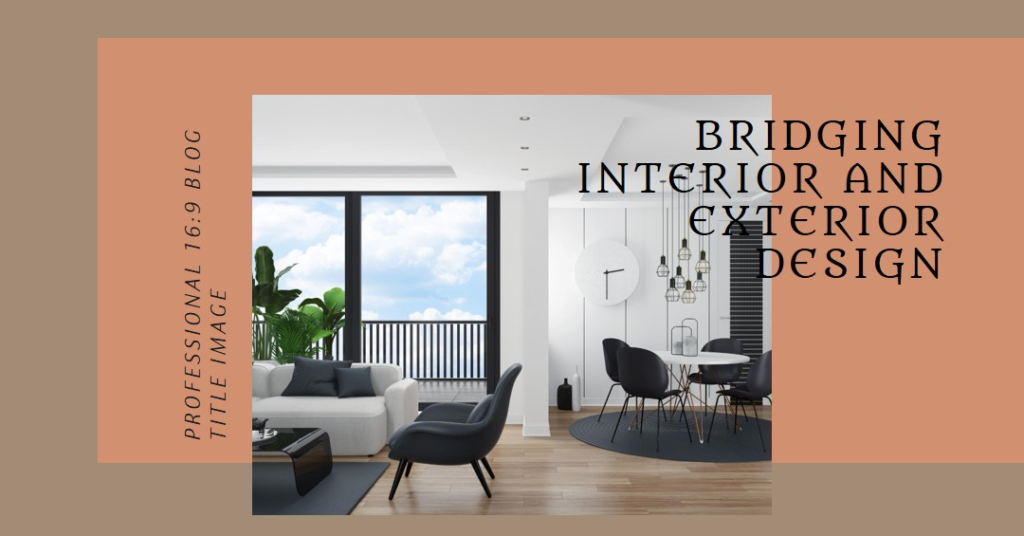
Table of Contents
- Introduction:
- Harmonizing Color Schemes:
- Consistent Architectural Elements:
- Embracing Natural Light:
- Integrating Outdoor Living Spaces:
- Blurring Boundaries with Landscaping:
- Creating Functional Outdoor Rooms:
- Continuity in Flooring Materials:
- Enhancing Entryways and Transitions:
- Personal Touches and Cohesive Decor:
- Conclusion: Achieving Harmony Between Inside and Out
Introduction:
The relationship between a building’s interior and exterior design is akin to a symphony, where every element must harmonize to create a cohesive and aesthetically pleasing whole. In the realm of architecture and design, bridging the gap between indoor and outdoor spaces is an art that requires a delicate balance of style, functionality, and comfort. This blog post will delve into the essential strategies and principles for seamlessly integrating interior and exterior design, ensuring a unified look and feel throughout your property.
Harmonizing Color Schemes:
Color is a powerful tool in design, capable of transforming spaces and evoking emotions. To bridge interior and exterior design effectively, start by harmonizing color schemes. Choose a palette that flows naturally from the outside in, creating a seamless visual transition.
For instance, if your exterior features earthy tones like browns and greens, extend these hues into your interior spaces. Use accent walls, furniture, and decor items to reflect the exterior colors. This approach not only creates a cohesive look but also establishes a calming, grounded atmosphere within the home.
Consistent Architectural Elements:
Architectural consistency is key to bridging interior and exterior design. Elements such as window styles, door designs, and rooflines should complement each other, creating a unified aesthetic. This doesn’t mean everything must match exactly, but there should be a clear visual connection between the inside and outside.
Consider the use of materials as well. If your exterior is dominated by natural stone, incorporate similar stone elements inside, perhaps in a fireplace or accent wall. This continuity in materials helps to blur the boundaries between indoors and outdoors, making the entire space feel more integrated and intentional.
Embracing Natural Light:
Natural light plays a crucial role in creating a seamless transition between interior and exterior spaces. Large windows, skylights, and glass doors are excellent ways to invite the outside in, flooding your home with natural light and offering views of the surrounding landscape.
Position furniture and design elements to take full advantage of these light sources. For example, place a cozy reading nook by a large window or a dining area near sliding glass doors that open to a patio. This not only enhances the connection to the outdoors but also maximizes the health and wellness benefits of natural light.
Integrating Outdoor Living Spaces:
Outdoor living spaces are an extension of your home’s interior, and their design should reflect this connection. Patios, decks, and gardens should be furnished and decorated with the same attention to detail as indoor rooms, creating a seamless flow between the two areas.
Use similar furniture styles, fabrics, and colors in both indoor and outdoor spaces. Consider adding elements like outdoor rugs, throw pillows, and potted plants to create a cohesive look. By treating outdoor areas as true living spaces, you can effectively bridge the gap between interior and exterior design.
Blurring Boundaries with Landscaping:
Landscaping is a powerful tool for merging interior and exterior design. Thoughtfully designed gardens, pathways, and outdoor features can create a natural extension of your home’s interior spaces. Consider the view from your windows and design your landscaping to complement and enhance these vistas.
For instance, place a beautiful flower bed or a tranquil water feature where it can be seen from the living room or kitchen. Use plants and trees that mirror the colors and textures of your interior decor. By creating visual connections through landscaping, you can make your home feel more expansive and integrated with its surroundings.
Creating Functional Outdoor Rooms:
To truly bridge the gap between inside and outside, consider creating functional outdoor rooms. These spaces, designed for specific activities, can enhance the usability of your property while maintaining a cohesive design aesthetic.
Think about adding an outdoor kitchen for alfresco dining, a cozy lounge area with comfortable seating, or a play area for children. Equip these spaces with all the necessary amenities to make them as functional and inviting as any indoor room. By doing so, you extend your living space and create a seamless transition between interior and exterior environments.


Continuity in Flooring Materials:
Flooring is another critical element in bridging interior and exterior design. Using consistent or complementary flooring materials helps to create a visual flow between spaces. Consider materials that work well both indoors and outdoors, such as stone, tile, or concrete.
For example, extend a tile floor from your kitchen out onto an adjacent patio, or use similar wood planks in both your living room and deck. This continuity in flooring not only enhances the overall aesthetic but also creates a more fluid transition between interior and exterior areas.
Enhancing Entryways and Transitions:
Entryways and transition areas, such as hallways and vestibules, are crucial points where interior and exterior design meet. Pay special attention to these spaces to ensure they reflect the overall design theme and facilitate a smooth transition between indoors and outdoors.
Use welcoming elements like well-designed doors, stylish lighting, and cohesive decor to create an inviting entryway. Incorporate outdoor elements, such as potted plants or natural materials, to blur the lines between inside and outside. By focusing on these transition areas, you enhance the overall flow and harmony of your home.
Personal Touches and Cohesive Decor:
Finally, personal touches and cohesive decor play a significant role in bridging interior and exterior design. Choose decor items that reflect your personal style and create a sense of continuity throughout your home. This includes artwork, textiles, and accessories that echo the colors, materials, and themes used in both indoor and outdoor spaces.
Consider displaying artwork that features nature scenes or botanical prints, and use textiles like cushions and throws in patterns that complement your exterior landscaping. By incorporating these personal and cohesive touches, you create a home that feels unified, intentional, and truly reflective of your style.
Conclusion: Achieving Harmony Between Inside and Out
Bridging interior and exterior design is about creating a harmonious and cohesive living environment. By focusing on elements such as color schemes, architectural consistency, natural light, outdoor living spaces, landscaping, functional outdoor rooms, flooring materials, entryways, and personal touches, you can seamlessly integrate your home’s interior and exterior.
The goal is to blur the boundaries between inside and outside, making your entire property feel like a unified, intentional space. This not only enhances the aesthetic appeal of your home but also improves functionality, comfort, and your overall living experience. With thoughtful design and careful planning, you can achieve a harmonious balance between interior and exterior spaces, creating a home that is beautiful, cohesive, and truly reflective of your personal style.



